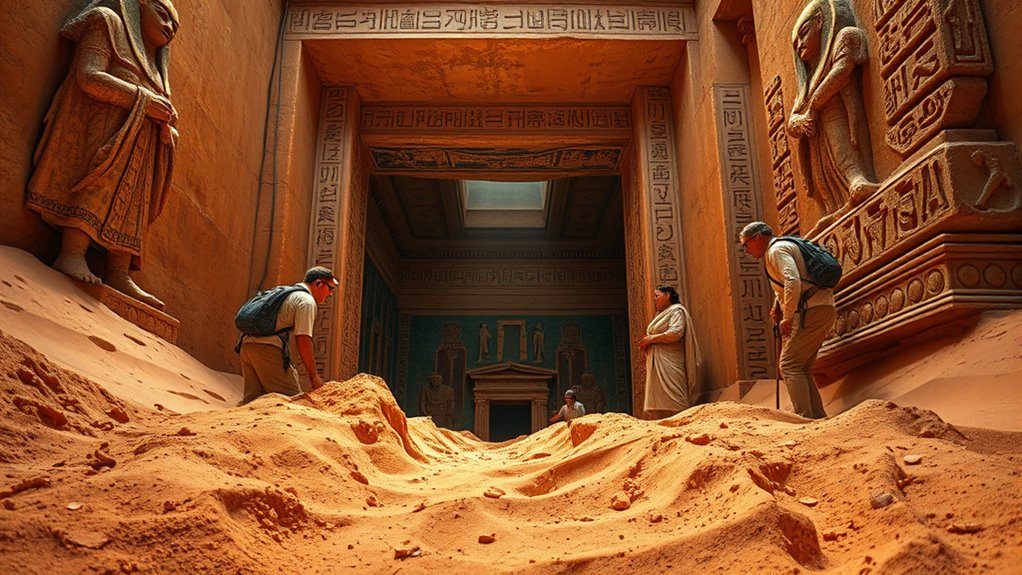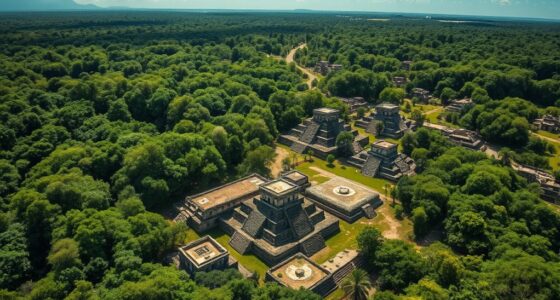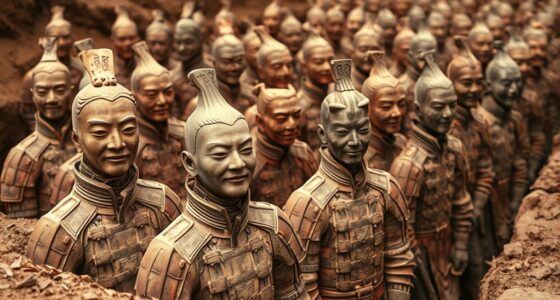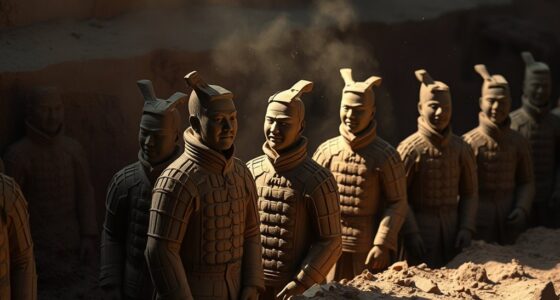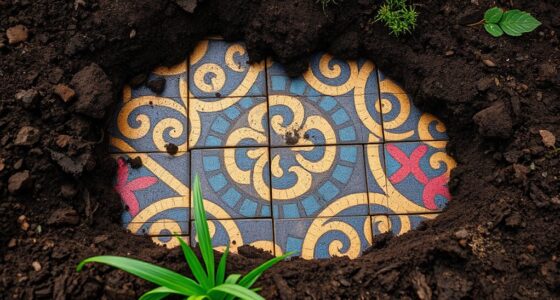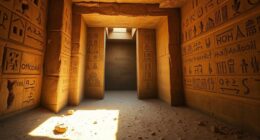Archaeologists have uncovered a 3,000-year-old Egyptian queen’s tomb, offering rare insights into ancient burial practices and religious beliefs. You’ll see carefully designed chambers filled with valuable artifacts like jewelry, amulets, and ritual tools that symbolize spiritual protection and status. The tomb’s layout reflects meticulous ritual planning, highlighting the importance of religious ceremonies. Keep exploring to discover more about the fascinating craftsmanship and cultural significance behind this extraordinary discovery.
Key Takeaways
- The tomb dates back over 3,000 years and provides rare insights into ancient Egyptian royal burial practices.
- Its carefully planned layout reflects the significance of rituals and spiritual journey for the queen’s afterlife.
- Artifacts such as jewelry, amulets, and ritual tools reveal religious beliefs, symbolism, and social status.
- High craftsmanship of artifacts and inscriptions offer detailed understanding of her identity and religious texts.
- The preservation of the tomb allows archaeologists to study sacred rites and cultural practices of ancient Egypt.
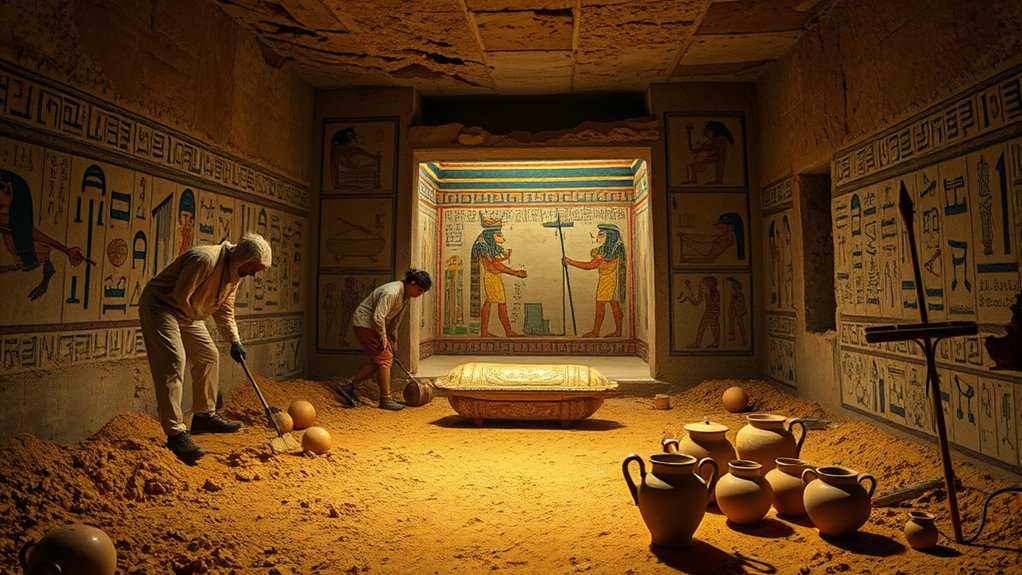
Archaeologists have uncovered the tomb of an Egyptian queen that dates back over 3,000 years, offering a rare glimpse into ancient royal burial practices. As you explore the site, you’ll notice how meticulously everything has been preserved, revealing the complexity of the rituals performed to honor the dead. The tomb’s layout reflects carefully planned ancient rituals; every chamber and corridor was designed to serve a purpose in the queen’s journey to the afterlife. These rituals weren’t just religious ceremonies—they were crucial to guarantee her safe passage and eternal protection.
Inside the tomb, burial artifacts tell a vivid story of wealth, status, and spiritual beliefs. You’ll see painted wooden coffins, jewelry crafted from gold and semi-precious stones, and intricate amulets meant to safeguard her in the afterlife. These artifacts weren’t randomly placed; each item had a specific ritual significance, designed to assist her in the next world. The presence of ritual tools, such as ceremonial vessels and ritual masks, emphasizes the importance of ancient rituals in the burial process. Every artifact you observe illustrates a belief in rebirth and divine protection, central themes in Egyptian spiritual life.
You might be struck by the elaborate nature of the burial artifacts—some of the jewelry features symbols of gods, while others depict scenes from her life or mythology. These artifacts weren’t just possessions; they were essential components of her spiritual journey, believed to grant her favor from the gods. The craftsmanship reveals a high level of skill and devotion, showing how much effort was invested in making sure her transition was smooth. You’ll also find inscriptions on some artifacts, offering insights into her identity and the religious texts that guided her burial rites.
The tomb’s preservation allows you to connect with ancient rituals firsthand, as if you’re stepping into a moment frozen in time. You can imagine the priests performing sacred rites, reciting prayers, and placing each burial artifact with precision. Such rituals were deeply symbolic, intended to align her spirit with divine forces and secure her eternal peace. The discovery of these artifacts and the tomb’s architecture provides invaluable insight into the religious and cultural practices of ancient Egypt, emphasizing how central rituals and artifacts were to their conception of death and the afterlife. Additionally, recent studies highlight the significance of ritual artifacts in understanding Egyptian religious beliefs.
This find is a remarkable window into a civilization that valued elaborate rituals and treasured burial artifacts as crucial elements of their spiritual journey. As you study the tomb, you gain a deeper appreciation for the ancient Egyptians’ intricate beliefs and the lengths they went to in ensuring their queens’ immortality.
Frequently Asked Questions
What Methods Were Used to Date the Tomb Accurately?
You use radiocarbon dating to measure the age of organic materials found in the tomb, giving you an approximate date. Additionally, stratigraphic analysis helps you examine the layers of soil and artifacts, providing context for the tomb’s age. Combining these methods, you gain a more accurate understanding of when the tomb was built, ensuring your dating process is thorough and reliable.
Were Any Artifacts Found That Suggest the Queen’S Identity?
You’ll be fascinated to learn that burial artifacts and hieroglyphic inscriptions found in the tomb strongly suggest the queen’s identity. These artifacts, including jewelry and ceremonial objects, provide essential clues. The hieroglyphic inscriptions help decode her name and status, giving insight into her life and reign. Such discoveries are indispensable for understanding Egypt’s ancient history and confirming her royal identity, making this find incredibly significant.
How Does This Tomb Compare to Others From the Same Era?
You notice that this tomb stands out for its elaborate royal symbolism and unique burial customs compared to others from the same era. Unlike simpler tombs, it features intricate wall carvings and valuable artifacts, highlighting the queen’s status. These elements reflect the cultural importance placed on royalty and the belief in preserving their legacy. Overall, it offers a richer glimpse into the burial practices and royal symbolism of that ancient period.
What Challenges Did Archaeologists Face During Excavation?
You might think ancient curses are just legends, but during excavation, they felt very real. Archaeologists faced the challenge of delicate excavation equipment that threatened to damage priceless artifacts. Unexpected structural collapses and hidden traps tested their patience and skill. Ironically, what was believed to be cursed kept them on high alert, turning an already complex task into a tense adventure where every move felt like defying ancient warnings.
Are There Plans to Display the Findings Publicly?
You’ll be pleased to know there are plans for a museum display and a public exhibition of the findings. The team aims to share this remarkable discovery with the world, allowing visitors to view the artifacts and learn about ancient Egypt firsthand. This public exhibition will highlight the tomb’s significance, offering an educational experience and fostering appreciation for Egypt’s rich history and archaeological achievements.
Conclusion
Imagine discovering a tomb like this, revealing secrets of ancient Egypt. Just like the tomb of Queen Nefertari, which offered invaluable insights into royal life, this find could reshape what we understand about Egyptian history. Your curiosity drives these discoveries, revealing stories buried for millennia. As you follow these archaeological breakthroughs, you realize each discovery brings us closer to understanding the fascinating world of the past—one ancient secret at a time.
